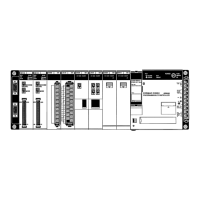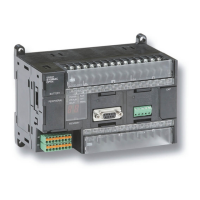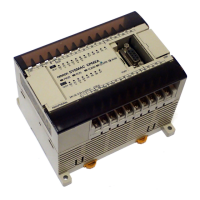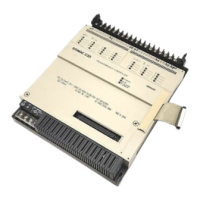103
4-7-7 Branching Instruction Lines
When
an instruction line branches into two or more lines, it is sometimes
neces
-
sary
to use either interlocks or TR bits to maintain the execution condition
that
existed at a branching point. This is because instruction lines are executed
across
to a right-hand instruction before returning to the branching point to
ex
-
ecute
instructions on a branch line. If a condition exists on any of the instruction
lines
after the branching point, the execution
condition could change during this
time
making proper execution impossible. The following diagrams illustrate this.
In both diagrams, instruction 1 is executed before returning to the branching
point and moving on to the branch line leading to instruction 2.
Instruction
1
00002
00000
Instruction 2
Branching
point
Instruction
1
00002
00000
Instruction 2
Branching
point
Diagram B: Incorrect Operation
Diagram A: Correct Operation
00001
Address Instruction Operands
00000 LD 00000
00001 Instruction
1
00002 AND 00002
00003
Instruction 2
Address Instruction Operands
00000 LD 00000
00001 AND 00001
00002
Instruction 1
00003 AND 00002
00004
Instruction 2
If,
as shown in diagram A, the execution condition that existed at the
branching
point
cannot
be changed before returning to the branch line (instructions at the
far
right do not change the execution condition),
then the branch line will be ex
-
ecuted correctly and no special programming measure is required.
If,
as shown in diagram B, a condition exists between the branching point and the
last
instruction on the top instruction line, the
execution condition at the branch
-
ing
point and the execution condition after completing
the top instruction line will
sometimes
be dif
ferent,
making it impossible to ensure correct execution of the
branch line.
There
are two means of programming branching programs to preserve the ex
-
ecution condition. One is to use TR bits; the other, to use interlocks
(IL(02)/IL(03)).
TR Bits The
TR area provides eight bits, TR 0 through TR 7, that can be used to tempo
-
rarily
preserve execution conditions.
If a TR bit is placed at a branching point, the
current
execution condition will be stored at the designated TR
bit. When return
-
ing to the branching point, the TR bit restores the execution status that was
saved when the branching point was first reached in program execution.
Inputting, Modifying, and Checking the Program Section 4-7

